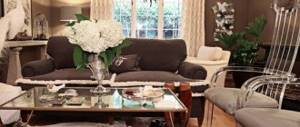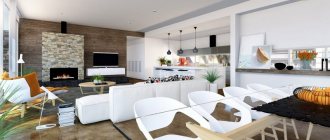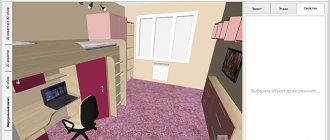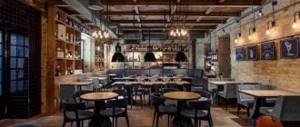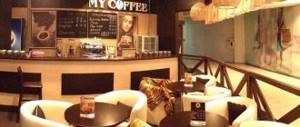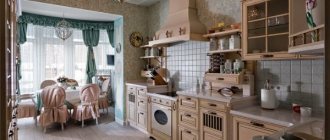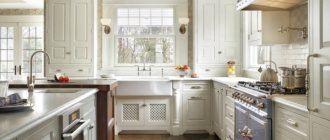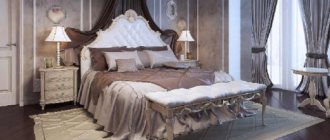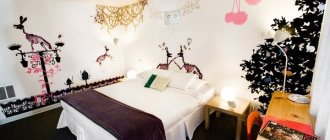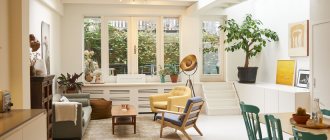In addition to tasty and fresh food, an important component of the success of any bar, cafe or restaurant is the interior. Therefore, owners of public establishments should take care of the design of the premises. A cozy atmosphere conducive to conversation and peace of mind will “make” visitors return to the restaurant again and again. There are many interior designs for a bar, restaurant or cafe. After all, each country has its own traditions, which leave their mark on the stylistic design of the hall. Competent interior decoration expresses the direction, main style and theme of the establishment, which helps attract the target audience.
Choosing a cafe style
Stylistic diversity opens up space for imagination. Decoration is perhaps the most pleasant and at the same time time-consuming stage before the official opening of your own establishment. The design will include a “tasty” interior and an alluring exterior. The interior decoration consists of the layout of individual rooms and zones, decoration, lighting, color scheme and decor, which polishes the style. First, you need to determine what category of people your establishment will be designed for. Cafes are classified into the following types:
- Coffee house. Making an invigorating drink is a priority.
- Small cafe. It offers a “full” menu, but the dimensions of the premises do not allow for a large flow of visitors.
- Luxury cafe. Such establishments almost reach the level of restaurants and receive mainly elite visitors.
- A pub. An establishment with night opening hours, where guests can have a glass or two.
- Cafeteria. The restaurant's menu is the same as in a cafe, but it operates on the principle of self-service.
- Budget fast food. A very popular option for serving “junk” food. The name “fast food” replaced the domestic buffet.
- Cafe with healthy food. Designed only for a certain category of people. The location of such cafes near sports complexes is relevant.
- Sports bar. It hosts live football and hockey broadcasts every day. Alcoholic drinks are offered to guests.
- Art cafe. A youth institution that welcomes creative individuals, where they can discuss issues of art.
- Dining room. A spacious cafe that receives a large flow of visitors every day. Usually located near large enterprises, office centers, banks. On weekends, celebrations are often organized here: banquets, weddings, anniversaries.
- Lobby bar. The establishment is located in the lobbies of hotels and inns. Intended for visitors and tourists. The cuisine is usually multinational.
Recently, more and more multifunctional cafes have been opening, which are more like small restaurants. Among the variety of styles, the following interior solutions can be noted:
- Loft or noble industrial. The style is now experiencing a real “boom”. Its calling card - brick walls are used in half of the fashionable interiors of houses and public institutions.
- Retro. The trend is relevant in narrow circles of connoisseurs of antiquity. Usually they reproduce the atmosphere of American jazz clubs, which were visited by ladies in fur coats and gentlemen in ties. Such cafes attract a bohemian audience who can plunge headlong into a new world of luxury and elegance.
- Russian. In this style, the main room is styled as a tavern with massive wooden furniture and a horseshoe over the entrance (for luck, as the saying goes).
- Fusion The direction is a stylistic potpourri. Fusion is classified as a more modern eclecticism. The style allows you to decorate the cafe in an unusual but cozy way. A complex interior solution will attract visitors from the “informal” category.
- Country. Rustic style that is characterized by simplicity. It allows the owner to save on finishing, but at the same time decorate the room in an original way.
- Provence. The classics of the French countryside are characterized by lightness and grace. For decoration, old furniture is used, which will look appropriate and organic in such an interior.
- Chalet. The direction arose on the Alpine slopes. It uses wood and natural materials. The facade is decorated with panoramic windows, and a fireplace will be a special sign of comfort.
- Eco style. Modern man is drawn to everything natural, which is why the interior emphasizes closeness to nature. For example, the central hall can be decorated with wooden logs instead of chairs, and compositions made of branches will act as the main decor on the walls.
- Disco style. Suitable for those who are nostalgic for the crazy 80s. The decor of the cafe will be flashy and provocative, using bright colors and posters of musical groups that were popular in those distant times.
- Empire style The direction is graceful. Floral ornaments and floral patterns are used in decoration. The furniture is neat on twisted legs, decorated with handmade carvings. The room is decorated with stucco.
- Modern. The style is characterized by lightness and unobtrusiveness. The interior is dominated by pastel colors and natural materials. The direction has taken an intermediate position between luxurious classics and laconic modern styles.
Separately, it is worth noting the ethnic style. By styling a cafe after a specific country with national cuisine, the owner will kill two birds with one stone:
- It will attract people from this state who miss their homeland to the establishment.
- It will lure locals who want to taste the exotic.
We often open cafes in ethnic style of two types:
- With interiors and cuisine from neighboring countries: Uzbek restaurants with traditional Tashkent pilaf, cafes with nostalgia for Armenia, or Ukrainian “huts” serving rich borscht and dumplings.
- Stylized as an establishment in exotic countries for domestic visitors. This includes Greek, Italian, American, and Mexican cafes.
Let us dwell on some styles, a detailed description of which will explain the reason for their popularity in the interiors of modern cafes.
In ethnic establishments, it is desirable that the staff speak the language of the country in whose style the interior is decorated. If you comply, then in everything.
Classic
Wood will prevail in classic decoration. It is used both for decoration and furniture. However, these are not rough country wood surfaces, but finely and carefully processed elements. Textiles use natural, “heavy” fabrics with delicate, elegant patterns. The classic style is not suitable for small rooms (less than 15-20 sq.m.). The problem is that in limited spaces it is difficult to implement it without losing some of the charm and luxury. Classic decor is very restrained; the style does not accept an abundance of small details that threaten to turn the interior into bad taste. The ceiling and walls are decorated with stucco; the entrance can be supplemented with an arched vault supported by columns. The main door is painted noble white and decorated with a gold handle and carvings. The color palette is dominated by brown, chocolate, olive, and golden. Crystal is also used in decoration: glasses, figurines, chandeliers. Classic style is more suitable for the interior of a restaurant.
The design uses simple geometry. It is unacceptable to overload a classic space with complex configurations.
Modern style
Modern interiors strive for laconism and simplicity. It cannot be said that this style has completely abandoned luxury, but it has become less flashy and more restrained. The direction was created in opposition to traditions. The interior colors are dominated by gray, white, black and accent bright touches: blue, cyan, violet. The classic embossed ones have been replaced by perfectly smooth surfaces. The preferred materials are metal, plastic, natural stone and brick. The room is decorated with marble tables, soft poufs and “pears” in the center of the room, stylish lamps of unusual shapes, and bright tableware. You shouldn’t forget about catchy shades, as they will help dilute the overall “sterility” of the atmosphere and bring coziness. Also, the room must be decorated with numerous lamps, sconces, and ceiling chandeliers. Lighting is developed on three levels, and special attention is paid to point light sources that highlight the advantageous aspects of the interior.
Minimalism
Minimalism is characterized by simplicity in design and an almost complete absence of decorative elements. A guest from the east came to us a couple of decades ago and has established himself in interior design for what seems like many years. Style loves freedom, large spaces, which seem even more spacious due to the light. However, so that the room does not create the impression of a continuous canvas, it must be zoned. It is relevant to use screens or decorative partitions between tables. Visitors will have the opportunity to delimit their personal space and at the same time remain part of the common room. In the color palette, primacy is given to white. The color of purity is emphasized with grey, black, blue, yellow. Stone, brick, wood, and plaster are used for decoration. The surfaces of the materials are deliberately not processed in order to emphasize their naturalness. The style is also characterized by an abundance of glass, in which rare decorative elements are made. Minimalism adheres to simple lines and shapes, excluding any “geometric” experiments.
Marine theme
Marine style is considered a favorite option for interior design in country houses on the beaches. Cafes, which are usually scattered along the embankment at the service of vacationers, also give preference to this particular direction. In cities where they only dream of the south before a vacation, an establishment decorated in a maritime style will evoke pleasant nostalgia and help you truly relax, as if you were on a good vacation. The palette of shades uses a “quartet” of tones: green, blue, indigo and white. The brown colors of the wood of the deck boards and steering wheels join their strong company. Furniture upholstery and textiles traditionally feature sailor stripes. In the decor you can use anchors and ships in bottles, telescopes, navigation devices, sails, lifebuoys, and tackle falling from the ceiling. An original solution would be to design the doorway in the shape of a steering wheel, the “spokes” of which will diverge to the sides along the walls. The windows are made small, like on ships. One of the accent walls is covered with photo wallpaper depicting an old world map or a treasure island. The design is printed on a “sheet” with charred edges on paper that has become “yellowed” with time. Some restaurateurs go further and embody the pirate theme in certain areas of the cafe. For example, the VIP room is decorated with massive chests with artificial gold, cages with live parrots and old lanterns as lampshades.
East style
Cafes in oriental style look unusual and fascinating. In interior design, it is imperative to develop soft, diffused lighting that gives a warm light. The floor is covered with tiles with ornate patterns. Complex patterns are one of the main features of the style, which is used on almost all surfaces. The tiles are partially covered with soft rugs. The seating areas are low and always decorated with numerous pillows. In oriental cafes, as a rule, guests are offered to smoke a hookah. It is more convenient to do this in separate rooms, which are separated from the common room by translucent curtains. Doorways are decorated with arches with characteristic vaults that have a sharp, elongated tip exactly in the middle. The room is decorated with a large number of round lamps that hang from the ceiling at different levels. In the color scheme, preference is given to shades of red, brown, and blue.
Italian style
The Italian style has retained many of the features of Baroque, which at one time gained wild popularity in this country. The palette of shades is dominated by brown, olive, terracotta, cream, orange, yellow, and brick. The finishing uses a combination of relief plaster, raw stone and solid wood. Moreover, noble varieties of the latter are chosen to emphasize the light luxury of the interior. The interior design uses massive, low furniture, which is decorated with upholstery with floral patterns. Alternatively, you can choose lightweight wicker chairs instead of stools. Collages of photographs are hung on the walls. Untreated ceiling beams and supports, which will also serve as conventional boundaries of combined zones, can become an important decorative element. Textiles chosen are richly decorated with patterns. Tables are usually covered with checkered tablecloths. The decor uses indoor plants, wicker elements, and wine bottles, which are taken outside the bar.
Japanese style
Japanese style is an integral part of the oriental one. He has retained its main features, but he himself is not devoid of individuality. Interior design in accordance with the canons of this trend is relevant for sushi bars and cafes with cuisine of the same name. Light-colored wood is used for decoration. The walls and ceiling are decorated with panels, which are used everywhere in the land of the rising sun. Seats for guests are decorated with low tables and mats or chairs without legs. The establishment is decorated with luxurious imitations of vases from the Ming era, panels depicting cherry blossoms, voluminous lanterns, and a path of flat stones right on the floor. The interior is decorated in neutral colors: white, black, brown, gray. The windows are covered with panel curtains made of silk, cotton, and linen. There must be live plants in the room.
Rococo
Rococo will be a good option for those with a fine artistic taste. In the room, the corners are slightly smoothed, as the style prefers smooth lines. The presence of high ceilings is one of the features of Rococo. The walls are decorated with expensive fabric wallpaper with the finest patterns. Light wood, ceramic tiles and marble are also used for cladding. In Rococo, a large amount of stucco is used, which is covered with gilding on top. The windows are covered with heavy curtains made of natural fabrics with the same floral pattern. The central element of the decor will be a huge crystal chandelier with light bulbs installed like candles. The prevailing shades are white, brown, wine, turquoise, blue, and pink.
High tech
High-tech interiors are modern and cozy, but it will be difficult for those who are all for tradition to stay in them. For this reason, the high-tech direction will give comfort mainly to the younger generation. This nuance should be taken into account when developing the concept of the establishment. Plastic, chrome and glass surfaces, untreated brick and stone are used in the decoration of walls and ceilings. The lighting is multi-level, neon-cold. It is better to lay the floor with a self-leveling floor with a glossy sheen. The furniture used is simple, with strict line geometry. The main shades are grey, white and black. The trinity can be supplemented with lilac, blue, red, cyan, yellow, that is, any color that is emphasized with appropriate lighting. The windows are panoramic. They are curtained with stylish blinds. Art objects in the style of cubism, constructivism, and futurism can serve as decor. They dilute the cold, technological atmosphere with indoor plants in square or triangular pots.
Children's Cafe
Some cafes create a separate children's area where parents can send their children and relax in peace. However, recently entire establishments that are designed only for children have been gaining popularity, a kind of culinary Disneyland for little ones. The central hall is usually divided into three zones:
- Common for all children;
- Boys' area. A recreation area for young pirates, robbers, astronomers, machinists and roboticists;
- A playground for girls where young princesses will find entertainment to their liking.
Any children's cafe should focus not on healthy but tasteless food (as most of us believed in childhood), but on confectionery and ice cream. Typically, children are taken to such establishments for special occasions, so the restaurateur should provide for the presence of a mini-banquet hall. Children's cafes are designed based on fairy tales, with bright decorations on the walls and similar decor. Sometimes they provide presenters with entertainment programs that will make the children’s holiday more vivid and memorable.
The restaurateur should also arrange a relaxation area for parents, that is, those adults who will come to look after the young company. The area should be separate so that children are not disturbed, but with a good view.
Summer cafe
A summer cafe can be of two types:
- A separate establishment that operates exclusively during the warm season and closes when cold weather sets in.
- A food court, which is attached to the main establishment and offers guests the choice of an additional area for relaxation.
As a rule, the summer zone is moved either to the backyard of the establishment, or directly in front of the facade and storefront. The terrace is equipped with light furniture. Be sure to have an awning on the roof, which will protect you from accidental rain. The summer cafe is decorated with potted indoor plants, dwarf trees, and curtains in improvised “windows” that help protect from the wind and scorching sun.
Hookah bar
The design of the hookah bar can be either modern or according to the canons of the classic oriental style. In the first case, smooth surfaces are used in the decoration, furniture of strict shapes, an abundance of white, and neon lighting. In the oriental style, tiles and textiles with a large number of subtle patterns are used. The main thing that should be provided in such an establishment is the presence of separate areas where guests can safely smoke a hookah. In some cafes, this service is included in the list of additional ones and for visitors who want to smoke a couple of smoky rings, they create separate places outside the common room.
Karaoke room
Karaoke cafes are considered more of a nightlife establishment. Of course, serious people can come here solely for the purpose of “stretching” their vocal cords, but much more often the stage is taken over by guests liberated by alcohol. A large number of the latter occur on Friday and Saturday evenings. There will be a rush at the karaoke bar ahead of the weekend. There are no strict restrictions on the type of interior design in an establishment. For example, a restaurateur can successfully embody country or Italian style in decoration. However, the common hall must be designed in such a way that visitors can easily observe the stage from any point.
Beer pub
The interior of a beer bar should be conducive to easy communication and relaxation. The atmosphere in establishments is often maintained as relaxed, conducive to the emancipation of visitors. They are often installed in basements. A cafe bar can expand its audience and broadcast sports matches daily. It is recommended to use wood and brick in the interior of the establishment. Shades are chosen from the “natural” range, that is, from tones of brown. The natural atmosphere will encourage the consumption of light alcohol, which will increase revenue.
Design project
The design project can be entrusted to a professional. Restaurateurs who are not constrained by budgetary constraints can afford such a step. However, newcomers to the restaurant business often refuse the services of a designer. And we are talking here not only about savings, but also about the opportunity to make the establishment an original one, as they say, “from start to finish.” If you decide to decorate a cafe with your own hands, then first you will need a pencil, tape measure, drawing paper and cardboard for the layout. First of all, carefully measure the room, because every meter will be used in the interior. Then they are transferred to a schematic drawing of the room. Measurements will be needed when choosing furniture and calculating the amount of finishing materials. Then, in the cafe drawing, they begin to outline the approximate location of the furniture. Don't forget to mark the work area for staff - the kitchen and toilet. By the way, the location of the latter should be chosen so that guests from anywhere in the hall can reach it without attracting unnecessary attention. At the design stage, the stylistic picture is already firmly ingrained in the head, so it is simply transferred to paper. Then they make a model and polish the situation, eliminating errors.
Cafe design idea and decoration map
In the design of cafes, bars and restaurants, textiles play one of the main roles, which determines whether the interior will turn out competent. The upholstery of chairs and upholstered furniture has a significant impact on the overall composition. Not to mention tablecloths and curtains. In the interior of the Bonasera cafe, private designers Ruslan and Maria Green suggest using textiles in pink and turquoise shades when upholstering chairs with a “carriage” screed. Numerous lampshades, reminiscent of Chinese lanterns in their shape, echo the palette of the furniture. Using checkered and striped patterns, designers somewhat complicate the composition, giving it a certain rhythm. The map of decorative finishing shows that when selecting materials and textiles, Ruslan and Maria Green focused on natural shades and textures.
Bar counter
The presence of a bar counter is not only an attribute of establishments with the same name. It is installed everywhere, since among guests from any category there will be those who want to pass the time with a glass of strong drink. In bars, counters occupy the lion's share of the common room area. In establishments that focus on delicious cuisine, the “alcohol” corner is located on a small area. Bar counters are designed in accordance with the general stylistic decision, but they most often become accent areas, highlights of the interior, against which they stand out. They are required to be equipped with high chairs for guests. Spectacular lighting will highlight the peculiarity of the interior object.
Airy cream shades in cafe design
In the cafe design, the color basis is a light creamy shade, reminiscent of whipped cream. Against this background, pink accents look like berries in strawberry yogurt. Along the long window, which provides the room with good natural light, the designers proposed placing areas with wide coffee sofas. Seats at such tables are especially in demand among those who go to restaurants to chat with friends or celebrate an event in close company. In window decoration, instead of the usual curtains, designers use curtains with curls that transmit light well.
Cafe equipment
By equipping a cafe we mean a set of technical equipment that ensures its high-quality operation. Only coffee makers and cocktail shakers behind the bar counters will be visible to visitors. Dishwashers, mixers, stoves, ovens, fryers - all this equipment is located in the kitchen area, which is hidden from the eyes of visitors. True, experimental options have recently come into fashion, where chefs demonstrate the entire process of cooking for guests through a glass partition. Even if the equipment is hidden from visitors, this does not mean that you need to save on it. The interior plays a big role, but if terrible-tasting dishes are served in a pleasant environment, no one will want to return to the cafe. It is more profitable for restaurateurs to purchase equipment in a comprehensive manner, that is, as a complete set, since sellers offer good opportunities to save money. Technology becomes an important part of the interior only in high-tech and modern style, close to it in spirit.
Design of a bathroom in a cafe
At the entrance to the bathroom, private designers placed a tall narrow mirror in a patterned silver baguette and a turquoise pouf with a “carriage” screed. Ladies will certainly appreciate this area, where you can quickly take a look at yourself and fix your hair. The design of the bathroom is quite laconic. The use of concrete surfaces gives this room a certain brutality. The gray color, characteristic of noisy cities, is diluted in this interior with turquoise accents.
